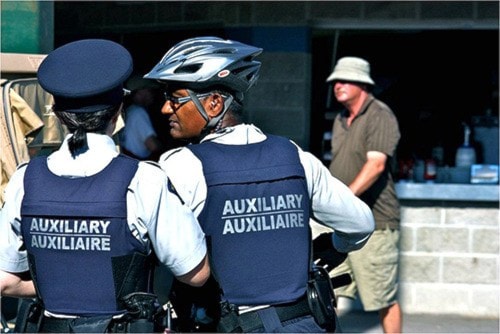SURREY — Surrey Mayor Linda Hepner said the city favours the third of three options governing the future of the RCMP’s Auxiliary Constable Program.
This option, which Hepner said is also the favoured choice of the Union of B.C. Municipalities, presents a three-tiered system which she says “allows us the broadest range of services.”
“I think it’s a better option for both the city and the volunteers,” Hepner told the Now. “It may very well take them into a career of law enforcement.”
The three options the RCMP is considering include settling with the status quo, setting up a community corps programs, or adopting a three-tiered program that would incorporate both options one and two.
In January Surrey’s roughly 80 volunteer cops – the largest contingent of roughly 1,500 auxiliaries across Canada – learned from RCMP headquarters in Ottawa that they would no longer be able to ride with Mounties, receive firearms familiarization training, and that their uniforms will be changed to better distinguish them from regular officers.
This came after a year-long review following the fatal January 2015 shooting of Constable David Wynn at a casino outside Edmonton. Auxiliary Constable David Bond, a volunteer police officer since 2008, was also injured.
Under the status quo (aka Option 1) the volunteers would remain appointed police officers, wear a “police-type” uniform and be issued “intervention tools” and soft body armour.
Under Option 2, the auxiliary constables would wear a “civilian-type” uniform, not be peace officers, and their duties would be restricted to safety education and crime prevention initiatives.
Option 3 – the one Hepner says the City of Surrey favours – features a three-tiered system with each tier having specific requirements for experience and training.
The first tier would see volunteers duties and training standards comply with that of Option 2; the second tier would included all status quo duties as well as traffic and crowd patrol, policing parades and public ceremonies, and foot beat and bike patrol under regular Mountie supervision. These Tier-2 volunteers would be peace officers, wear a “police-type” uniform and be issued “intervention tools” and soft body armour. Their participation would be restricted to 96 hours each year with a 9 p.m. curfew.
Finally, Tier-3 volunteers would perform first and second-tier duties as well as general duty patrol in an RCMP vehicle, be it an ATV, snow mobile, boat, bike or on foot. Their training would include firearms “familiarization” training and participation would be set at 144 hours annually with a midnight curfew.
The RCMP’s Auxiliary Constable Program has been running for more than 50 years in B.C. It is governed by provincial policy, and has roughly 700 active volunteers helping police in 67 RCMP detachments throughout the province, all told volunteering about 120,000 hours of service each year.
